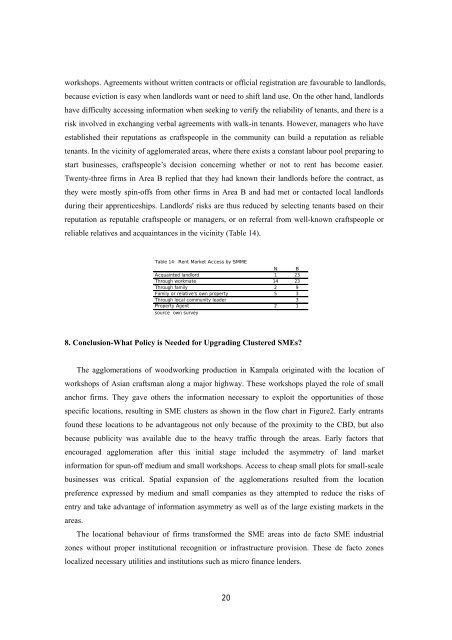Information - ARRIDE - IDE-JETRO
Information - ARRIDE - IDE-JETRO
Information - ARRIDE - IDE-JETRO
You also want an ePaper? Increase the reach of your titles
YUMPU automatically turns print PDFs into web optimized ePapers that Google loves.
workshops. Agreements without written contracts or official registration are favourable to landlords,<br />
because eviction is easy when landlords want or need to shift land use. On the other hand, landlords<br />
have difficulty accessing information when seeking to verify the reliability of tenants, and there is a<br />
risk involved in exchanging verbal agreements with walk-in tenants. However, managers who have<br />
established their reputations as craftspeople in the community can build a reputation as reliable<br />
tenants. In the vicinity of agglomerated areas, where there exists a constant labour pool preparing to<br />
start businesses, craftspeople’s decision concerning whether or not to rent has become easier.<br />
Twenty-three firms in Area B replied that they had known their landlords before the contract, as<br />
they were mostly spin-offs from other firms in Area B and had met or contacted local landlords<br />
during their apprenticeships. Landlords' risks are thus reduced by selecting tenants based on their<br />
reputation as reputable craftspeople or managers, or on referral from well-known craftspeople or<br />
reliable relatives and acquaintances in the vicinity (Table 14).<br />
<br />
<br />
<br />
<br />
<br />
<br />
<br />
<br />
<br />
<br />
8. Conclusion-What Policy is Needed for Upgrading Clustered SMEs?<br />
The agglomerations of woodworking production in Kampala originated with the location of<br />
workshops of Asian craftsman along a major highway. These workshops played the role of small<br />
anchor firms. They gave others the information necessary to exploit the opportunities of those<br />
specific locations, resulting in SME clusters as shown in the flow chart in Figure2. Early entrants<br />
found these locations to be advantageous not only because of the proximity to the CBD, but also<br />
because publicity was available due to the heavy traffic through the areas. Early factors that<br />
encouraged agglomeration after this initial stage included the asymmetry of land market<br />
information for spun-off medium and small workshops. Access to cheap small plots for small-scale<br />
businesses was critical. Spatial expansion of the agglomerations resulted from the location<br />
preference expressed by medium and small companies as they attempted to reduce the risks of<br />
entry and take advantage of information asymmetry as well as of the large existing markets in the<br />
areas.<br />
The locational behaviour of firms transformed the SME areas into de facto SME industrial<br />
zones without proper institutional recognition or infrastructure provision. These de facto zones<br />
localized necessary utilities and institutions such as micro finance lenders.<br />
20




![Title [書評] 廣田義人著『東アジア工作機械工業の技術形成 ... - ARRIDE](https://img.yumpu.com/47139953/1/184x260/title-arride.jpg?quality=85)






